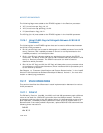
Vol. 3 19-5
ARCHITECTURE COMPATIBILITY
19.10 INTEL HYPER-THREADING TECHNOLOGY
Intel Hyper-Threading Technology provides two logical processors that can execute
two separate code streams (called threads) concurrently by using shared resources
in a single processor core or in a physical package.
This feature was introduced in the Intel Xeon processor MP and later steppings of the
Intel Xeon processor, and Pentium 4 processors supporting Intel Hyper-Threading
Technology. The feature is also found in the Pentium processor Extreme Edition. See
also:
Section 8.7, “Intel
®
Hyper-Threading Technology Architecture.”
Intel Atom processors also support Intel Hyper-Threading Technology.
19.11 MULTI-CORE TECHNOLOGY
The Pentium D processor and Pentium processor Extreme Edition provide two
processor cores in each physical processor package. See also:
Section 8.5, “Intel
®
Hyper-Threading Technology and Intel
®
Multi-Core Technology,” and Section 8.8,
“Multi-Core Architecture.” Intel Core 2 Duo, Intel Pentium Dual-Core processors,
Intel Xeon processors 3000, 3100, 5100, 5200 series provide two processor cores in
each physical processor package. Intel Core 2 Extreme, Intel Core 2 Quad proces-
sors, Intel Xeon processors 3200, 3300, 5300, 5400, 7300 series provide two
processor cores in each physical processor package.
19.12 SPECIFIC FEATURES OF DUAL-CORE PROCESSOR
Dual-core processors may have some processor-specific features. Use CPUID feature
flags to detect the availability features. Note the following:
• CPUID Brand String — On Pentium processor Extreme Edition, the process will
report the correct brand string only after the correct microcode updates are
loaded.
• Enhanced Intel SpeedStep Technology — This feature is supported in
Pentium D processor but not in Pentium processor Extreme Edition.
19.13 NEW INSTRUCTIONS IN THE PENTIUM AND LATER
IA-32 PROCESSORS
Table 19-1 identifies the instructions introduced into the IA-32 in the Pentium
processor and later IA-32 processors.


















